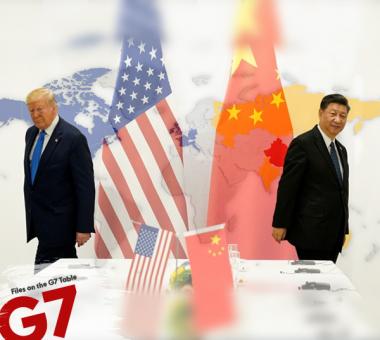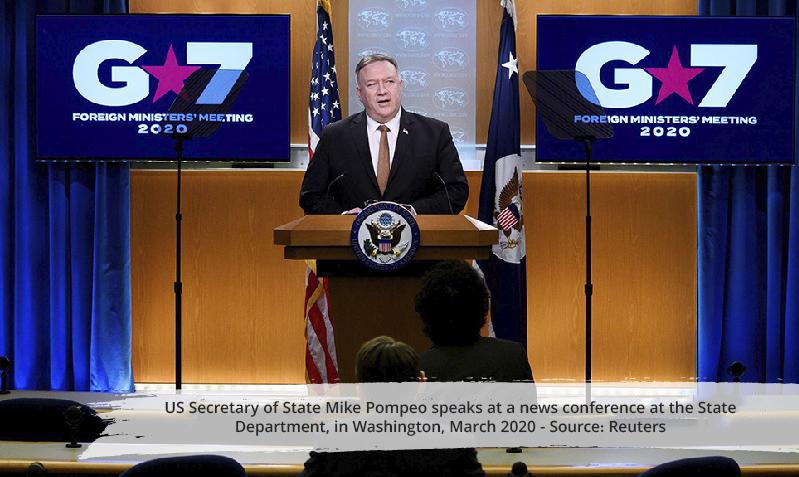"G7+" vs. China: Underlying Trends and Challenges
The 46th G7 summit will likely witness an expansion after inviting Russia, Australia, South Korea, and India to the summit meetings; a step that many observers consider as part of U.S. policy to contain China's growth. Hence, this article explores the underlying trends behind the G7 expansion, and the challenges facing U.S. President, Donald Trump, in his efforts to transform the G7 into an anti-China platform.
by STRATEGIECS Team
- Publisher – STRATEGIECS
- Release Date – Aug 30, 2020

*This is the sixth material of a series that is being published in succession in the file “papers on the G7 table.”
It is said that the United States is intending in this year`s session of the group of 7 (2020) to form a “G11” by inviting South Korea, Australia, Russia and India to attend. Such step is agreed upon by several observers to be an attempt by the American president, Donald Trump, to create a new anti-china platform. This invitation, as well, highlights an upward trend in making fundamental changes in the nature of the G7, as Trumps invitation was proceeded by a suggestion made by the British prime minister, Boris Johnson. According to “The Times”, Johnson called for including India, South Korea and Australia in the G7 to transform it into a democratic platform of 10 countries “D10”, to face the technological development of China.
In this perspective, we can analyze the expansion of the G7 in its 46th session and the intentions behind this expansion – regardless if it turned out to become a permanent change or not – in three main directions, the first focuses on the United States policy to contain the Chinese growth, considering that South Korea, Australia and India are allies to the United States, and were mentioned in the U.S. national security strategies in 2017 as partners in the American Pacific and South China Sea Strategy. South Korea also has a joint defense treaty with the U.S., while Australia supports Trump`s approaches in conducting an independent investigation to find the source of "novel coronavirus", and it also condemned the national security law in Hong Kong. As for India, it is considered to be one of the most prominent military and politically allies in the region, in addition to being one of the most important American strategic pillars to contain the Chinese growth.
By inviting these countries, President Trump aims at balancing the attitudes of the G7 towards china, especially that participating European countries – except for Britain – does not fear the Chinese growth as the U.S. does, rather, they find in many aspects of this growth an economic opportunity, not to mention their discrepancy in estimating the Chinese danger, that`s why Trump failed in his previous attempts to push the G7 towards challenging the Chinese growth. The main hope here is that the presence of these three countries in addition to Japan may form the needed momentum to shed more light on the issues related to China inside the group.
The second direction is interested in reinforcing the geopolitical presence of the G7 after realizing the need of a bigger international representation, especially of countries located in the vital periphery of china, and in this manner, if the three countries do join the G7 – all of which are countries of the liberal world led by the United States, and all have democratic systems that defend the international order of “post-cold-war” phase – they will increase the power and influence of the group in the vital sphere of china, thus creating a geopolitical balance with it.
The third direction is interested in chances that will be provided by the joining of these three middle powers (India, Australia and South Korea) to the club of G7 that will enhance their commercial cooperation and coordinate their policies within a multilateral mechanism, thus increasing their influence in Asia and the Indian and pacific oceans.
In this direction, we can enlist Russia, the fourth invited country to the G7 session of this year, considering that this invitation might cause a rift in its relations with China, but the former settled its position - ostensibly – regarding the agenda of the expected session even before it was held, according to Russian foreign ministry spokeswoman, Maria Zakharova, saying that any projects that have an international importance are hard to discuss practically without China, which is an implicit rejection to take any position against it.
But these three directions will have problems in practice that cannot be overlooked and will lead to raising several questions that need answering. One of the most important questions is: does American diplomacy have the capability to use the G7 as a club against China? Will the invited countries be willing to follow the lead of the American policies against China?
It`s worth mentioning that the American diplomacy in the G7 can no longer win support for its political agenda, particularly against China. The American efforts failed in the virtual meeting of the G7 foreign ministers that was held on march 25th 2020 to discuss the latest developments in “novel coronavirus” impacts. The U.S. minister of foreign affairs, Mike Pompeo, called the virus in the statement of the session: “Wuhan virus” in attempt to hold China accountable for the economic consequences of the pandemic, but this suggestion was rejected by the other six countries.
And in the same way, “The Guardian” British newspaper pointed out the insistence of the White House to show that the group supports the American criticism levelled at the World Health Organization by stating that: "Much of the conversation centered on the lack of transparency and chronic mismanagement of the pandemic by the WHO … The leaders called for a thorough review and reform process.”, the facts, on the other hand, show the opposite, as the six countries supported WHO and some of them even increased financial aid provided for the organization such as Britain and Canada.

Consequently, asserting that it would be very hard to transform the G7 into an anti-China group is a very reasonable assertion, and the main question would be: will the expansion of the G7 by adding Australia, India and South Korea result in accomplishing Trump`s aims? would it leave a milestone on the agenda of the summit and its final statement?
And here we can answer this question by evaluating the benefits and risks for these countries if they decided to support Trump in the G7, as follows:
First: the American Chinese competition is a very sensitive issue, the observers of this rivalry express fears of a new cold war between the two countries, not to mention a long term economic competitiveness that will be pathed by more exchanged sanctions and official verbal escalation, while the U.S. allies find themselves facing the consequences of great powers competitions.
In this light, the three countries in addition to Japan seem to distance themselves – mostly – from being completely biased to any country, in efforts to avoid causing the potential threat to turn into an actual threat, for example, India does not want to take part in this competition because it will be the most affected by a fight of two countries who have no shared borders, while India have a complicated situation along its 3500km of shared borders with China, that`s why it manages any tensions there independently without American aid.
For instance, after the Indo-Chinese clashes in Ladak Province in June 15th 2020, India refused American mediation to calm tension, rather, it used its soft and rough tools to respond to the Chinese escalation, carrying on, at the same time, negotiations to reduce this tension.
Second: the three countries focus in their relations with China on economic and commercial collaboration, and the economic growth of China creates economic and investment opportunities for these countries. The South Korean president, Moon Jae-in expressed this idea by stating: “It is hoped that South Korea’s dream becomes helpful for China as China’s dream becomes an opportunity for South Korea.”
-كوريولالصين-1700x680.jpg)
So far, the economic relations among these countries (especially Australia and South Korea) and China are more of an economic dependance, on the contrary to countries in the G7 that have more diverse economies. China, for example, is Australia`s biggest trade partner with a commercial exchange that reached 152 billion dollars in 2018, the same goes for South Korea with a commercial exchange of 313 billion dollars in the same year, and India that increased its exchange to about 94 billion dollars compared to 89 billion exchange with the U.S., not to mention that the economies of these countries (especially Australia and South Korea) are closely affected by China`s economic indicators. A study published by Australia-China Relations Institute (ACRI) based on recent studies, showed a 0.1 to 0.2% decrease in Australian gross domestic product as a respond to 1% decrease in Chinese GDP.
Thus, it is highly unlikely that these countries would be willing to sacrifice their economic relations with China to accommodate American policy, and even after the existing tensions between the U.S. and some European countries with China regarding the Hong Kong national security law, and the accusations in the matter of “novel coronavirus”, still, the South Korean president, Moon Jae-in, is planning to receive the Chinese president, Xi Jinping at the end of 2020.
Third: what makes economic relations of the three countries with China even more complicated, is China`s use of its economic power as a political tool. Such action is clearly manifested in several occasions, for instance, China suspended rare metals exports to India in 2010, and punished South Korea for approving to the deploying of American missile defense system “THAAD” in 2017, causing a significant drop in the number of Chinese tourists visiting South Korea estimated by 41% annually according to the Korean tourism organization. Likewise, China imposed tariffs on Australian barley and banned four major Australian beef providers after the latter supported an American decision to conduct an investigation to find out if China was responsible for the spread of the “novel coronavirus”.
-ثاد-منظومة-1700x680.jpg)
In the case of South Korea, the country tried to ease the pressure caused by the Chinese informal sanctions by signing an agreement with China to resume economic relations, known as “Three No`s” agreement, which refers to: no additional THAAD deployment, no participation in the U.S. missile defense network and no establishment of a trilateral military alliance with the U.S. and Japan.
Fourth: after many expectations that the U.S. will support its allies in crises, the “Three No`s” agreement confirmed that following the U.S. policies in confronting China causes more harm than good, and we refer here to the fact that the U.S. left South Korea to handle its crisis alone, which was not a rare incident. The same thing happened to Canada, when China responded to Canada`s arrest of a Chinese technology executive official at the request of the United States by banning import of the Canadian canola oil and arresting some Canadian citizens.
As for Australia, it also faces a similar position. The defense update of 2020 refers to a retreat in the Australian confidence in Expanded American deterrence against nuclear threats, according to the Australian Strategic Policy Institute. The lack of confidence in the U.S. is not limited to the three countries alone. Japan, for example, is furthering its quiet rapprochement and collaboration with China, which can be explained as some sort of precaution in case the U.S. was not committed to supporting its allies. This explains Japan’s partial change in attitude towards the Chinese American competition voiced by the Japanese prime minister, Shinzō Abe, who resigned in august 28th, 2020, when he said: "Retaliatory measures do not benefit anyone." which is an implied call for initiating a Chinese American dialogue.
On a broader scope, the liberal and democratic unity, especially inside the G7, is facing some ambiguity, under this situation of disputes between the U.S. and Europe, and also inside the European Union itself, that`s why following the lead of the G7 and taking place in the anti-China clubs will not probably be the choice of the three countries.
In the last minute, Trump may have chosen a bad timing for the summit – if it was held – only a few weeks prior to the American presidential elections, although he hoped – apparently – that this summit may be an opportunity for him to increase his chances among American voters by gaining diplomatic points, still, any position that may be taken against China will be highly symbolic and somehow ineffective.
Away from the shape of summit, its members and their count, the leaders in the G7 and the leaders of the invited countries will be very cautious in supporting Trump`s agenda so that they do not appear as supporters for him in the elections. On the other hand, those leaders are unlikely to throw their weight behind Trump in a time were the majority of opinion polls shows that Biden is ahead of Trump, and in case he actually wins, it is certain that Biden will endeavor to ease the escalation with China, and once again, these countries will find themselves forced to face the Chinese sanctions – solo – as a penalty for any support they may show for the anti-China American policies.

STRATEGIECS Team
Policy Analysis Team
 العربية
العربية